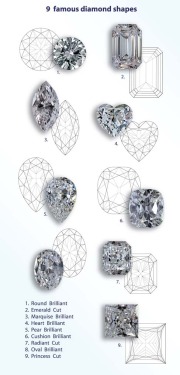 Oval Brilliant Cut:
Oval Brilliant Cut: Shape: oval,
Cut: Bright/splendid origin: 19th century.
There is a bow tie effect. Its original stone retention rate can reach 50% to 60%, suitable for long octahedral diamond rough. Also because it preserves the diamond's higher quality, it is used in many ancient diamond outlines for recutting: Pear Brilliant Cut:
Shape: Pear-shaped cut: Bright/splendid Origin: In the 17th century, it was also known as Tear Cut or Pendloque Cut with a bow tie effect.
Pear-shaped cuts were very popular during Louis XIV in France. Nearly 20% of the famous diamonds in history use such cuts, including the world’s largest diamond: Cullinan 1. This type of cutting is suitable for processing rough diamonds with broken or flawed edges. When inserting, care must be taken at the sharp corners. Profile requirements: symmetrical on both sides, sharp corners without Marquise Brilliant Cut:
Shape: Marquise-shaped cut: Bright/splendid Origin: In the 17th century, King Louis XIV was also translated as horse-eye drill or boat-shaped cut. These cut diamonds are pointed at both ends, resembling a nucleus, hence the name. There is a bow tie effect.
This cut stone has a low retention rate and is characterized by sharp corners at both ends, where the inclusions can be well concealed and the sharpness at the corners is extremely high. When inserting, care should be taken to protect the sharp corners.
Profile Requirements: Symmetrical, Square-Free Cut (Square Brilliant Cut):
Shape: Square Cut: Bright/Splendid or Mixed Origin: Invented by Belgian craftsmen in the middle of the last century, this type of cut was continuously refined and a series of improved forms were derived.
Due to the improved form of the ladder-type cut, it can also be classified as a hybrid cut.
Square cuts have a square or rectangular shape, usually with 76 facets. But there are also 61, 101 facets or 144 facets. One of the 101 faceted square bright cuts is E. F. D. Diamond company's registered patent cut, that is, Princess Fang.
Square cuts can be diversified, but generally have a shallow crown, a large countertop, and a deep pavilion.
The retention rate of such cut roughs is higher than that of other bright cuts, but it is not applicable to shallow drills in pavilions.
The brightness and flicker produced by the sharp corners and pavilion facets reduce the visibility of the inclusions and also slightly increase the color grade of the diamonds, and the square-cut diamonds of the same weight appear to be more contoured than the round cut diamonds. To be about 15% larger.
The square shape is suitable for seamless inlaying of diamonds. This is not possible with diamonds of other shapes, but sharp corners need to be protected when inlaid.
Heart Brilliant Cut:
Shape: Heart-Shape Cut: Bright/Splendid Origin: Modern diamonds are symmetrically shaped with two wing flaps, a median groove, and a sharp corner at the bottom. It looks like a heart.
Heart-shaped cut diamonds are deep and shallow, and are suitable for irregularly shaped and relatively flat diamonds. The inclusions in the original groove position can be removed to improve the diamond's clarity, but the retention rate of this kind of cut stone is relatively low. low.
The evaluation of the shape of the heart-shaped diamond mainly focuses on the symmetry and full shape of the bilateral flaps.
Emerald Cut:
Shape: Rectangular Cut: Ladder Origin: Derived processing method for ancient typical ladder-type cuts, all cut surfaces are parallel or perpendicular to the square outside waistline of the diamond, the shape is rectangular, the pavilion and the crown are relatively flat, and the cusp harvesting line shape. Because it is commonly used in gem emerald processing, hence the name.
Using emerald-cut diamonds, it is difficult to cover the inclusions. It is suitable for rough diamonds with high clarity, rectangular shape and slightly damaged corners or inclusions. The retention rate of rough stones can reach 60% to 70%.
Profile Requirements: Be careful to cut the size of the four corners, the line surface must be strictly parallel Radiant Cut (Radiant Cut):
Shape: Rectangular Cut: Mixed Type Origin: 1977 Radiant Cut was invented in 1977. The craftsman hopes to create such a cut by combining the elegant appearance and round cut brightness of emerald cuts.
The Radiant has rectangular shapes and cut-away corners. It takes into account the high stone retention rate and easy-to-fit shape of emerald cuts, as well as the excellent light performance such as round brilliant cuts.
The Radiant cuts are suitable for a slightly rectangular shape, with rough and broken stones in the four corners, and a high retention rate of the original stone.
When inlaid, at least four claw-removed corners should be fixed in the form of four-jaw inlaid to ensure the firmness and security of the inlay.
Cushion Cut:
Shape: Rectangular Round Cut: Bright/Splendid Classic Origin: In 1977 it was also known as Pillow Cut.
There are 58 cuts in the mat type cut, which is now the predecessor of the bright cut. In comparison: the countertop is smaller, the other facets are larger, the waistline of the diamond is thinner, the whole is flatter, and the bottom tip is processed into a small section, then a "hole" can be seen inside the diamond from the tabletop.
Pad type cuts spread from the 19th to the 20th century. It was a cutting method that has been developed and improved many times. Before that, diamonds have undergone several modifications. Since 1830, diamonds have been used for almost a century and only Use this cut, including many of the world-famous diamonds, such as: Hope, Regent and so on.
Compared to modern bright cuts, cushion-cut diamonds have a higher scattering fire.
Hand Sewing Designs Sweater,Long Cashmere Cardigan ,Ladies Cashmere Sweaters ,Camel Cashmere Sweater
Sweater,Shawl Co., Ltd. , http://www.nbknittingsweater.com